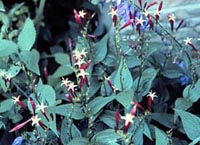Resource Library
Plant of the Week: Pinkroot (Indian Pink)
The University of Arkansas System Division of Agriculture does not promote, support or recommend plants featured in "Plant of the Week." Please consult your local Extension office for plants suitable for your region.
Plant of the Week
Indian Pink, Pinkroot
Latin: Spigelia marilandica

Choosing the most beautiful blossom in the plant world is a fruitless chore, but if
one were to do so, the native wildflower Indian Pink would probably rank high on the
top ten list. At least it would on mine because I have a well developed gaudy streak.
I love bright color contrasts.
Indian Pinks are bright red on the outside and creamy yellow on the inside, a contrast
that would have caused garden classicists such as Gertrude Jekyll to shutter at the
thought of using such an abomination.
Indian Pink is native from New Jersey and through the southeastern states to Texas.
It’s a member of the Loganiaceae family, a rather heterogeneous family that includes
such plants as the semi-woody shrub Buddleia from China and the vining yellow jessamine (Gelsemium) from the eastern states.
Indian Pink grows to about 2 feet tall with sessile, opposite leaves whose margins
can reach up to 4 inches in length.
The showy flowers appear in mid-summer in a one-sided terminal inflorescence called
a cyme. The six to 10 red and yellow flowers point upward. The basal flower opening
first, with each succeeding bloom smaller and less developed than its neighbor on
the downhill side of the cyme. Individual blooms are to 2 inches long, tubular with
five star-shaped terminal lobes pointed outward at the end of the tube. The fruit
is a small, inconspicuous capsule enclosed in the calyx.
The genus name was given by Linnaeus and honors Adrian van der Spigel, a Brussels
doctor who wrote a text in 1606 detailing the procedure for developing an herbarium
to preserve dried plants.
An obsolete name for Spigelia is "wormgrass," so-called because a tincture prepared
from the pink roots was used to rid humans of worms. All parts of the plant are poisonous.
Apparently the plant is still used in some herbal medicinal preparations. Graphic
descriptions of the effects of improperly administering the herb on children can be
found on the web.
My personal acquaintance with Indian Pink came from Elmira Love, a lady who grew
up on the prairies of Nebraska and knew and loved wildflowers. Mrs. Love taught school
for years, and then well into her 80s wrote a nature column for the West Fork Observer in Washington County. Her Spigelia was her delight. She would always make a point
of showing it off when it was in bloom.
One day Mrs. Love called in distress. Some low-life had come into her garden, dug
up her plant and hauled it off. Such plant thievery is rare, but does occur among
even garden folk, who as a rule, are the salt of the earth.
Spigelia is available from the nursery trade, but you have to hunt to find it. It
can be propagated by cuttings with the slips taken in the spring as they emerge. Care
must be exercised to prevent them from rotting during the rooting stage. Seed does
not seem to be readily available in the trade.
Indian Pink is hardy throughout Arkansas and as far north as zone 5. It’s best sited
to well-drained, organic soil that receives good light but not direct sun. The north
or east side of a house makes a good location. Once established, the plant will form
a clump that will gradually get a foot or so across. Plants should be watered during
dry weather.
By: Gerald Klingaman, retired
Extension Horticulturist - Ornamentals
Extension News - August 11, 2000
The University of Arkansas System Division of Agriculture does not maintain lists of retail outlets where these plants can be purchased. Please check your local nursery or other retail outlets to ask about the availability of these plants for your growing area.